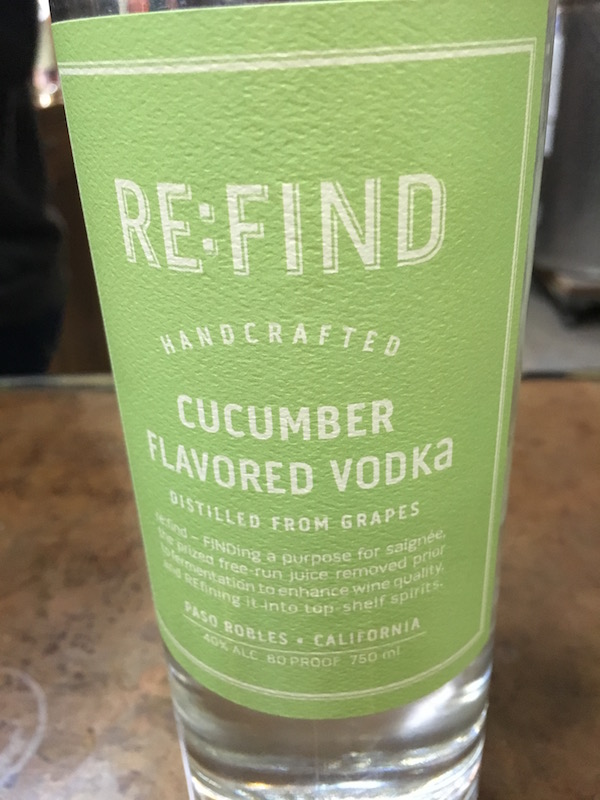Vodka and Gin From Grapes? Are You Crazy!
/Everyone knows vodka is made from potatoes or rye or wheat or corn or even beets or molasses, and gin is made from juniper berries and several other botanicals. Right?
Not at Re:Find Spirits, a sister venture to Villicana wines in Paso Robles!
We’ve been wanting to check this place out for quite some time, simply to be fair toward the non-wine enthusiasts around us. We’ve heard about this place for awhile, but were waiting to have a designated driver to take care of us, as our usual DD is one of those non-wine enthusiasts.
Villicana’s Re:Find spirits are distilled on site. This much we knew. We also knew they create a rye whiskey, along with vodka and gin. We were in for a surprise! Re:Find spirits are named that for a reason: its “vodkas” and “gin” are made from discarded free-run grape juice that occurs before fermentation begins.
Why would anyone think to do that?
The owners of Villicana, Alex and Monica Villicana, wanted to make their vineyard more ecologically-friendly and sustainable. That free-run grape juice, called saignée, can be fermented to create rosé but is oftentimes just dumped in the fields, however, isn’t the best thing for the soils. By triple-distilling the saignée, and adding all-natural flavors, a waste product is turned into highly drinkable adult beverage! Flavorings are added during a fourth distilling process. The distillery has been in production for four years.
We had the pleasure of having the very knowledgable Mary Kerrigan as our tour guide.
Each fermentation cycle is called a “cut.” At the end of each cut waste products are removed. As part of the stillroom tour, you are given the opportunity to smell each cut as it came from the still. The first cut, called the head cut, removes the acetone alcohol from the mix. This acetone alcohol, which is NOT safe for consumption, is used as an all-natural surface cleanser throughout the plant. The second cut, called the hearts cut, removes ethyl alcohol from the spirits, further refining the purity. At the conclusion of the third cut, the alcohol’s flavor has been further refined by removing chemicals that remain, making the alcohol more flavorful. There is no carbon filtering used in any of the distilling processes.
Unfortunately for the whiskey drinker in our party, we were about a month early for the most recent batch of rye whiskey to be tasted. But we were given the opportunity to taste Re:Find’s other spirits.
First of all, the vodka and gin have to be labeled as “brandy” as they are created from a fruit-based spirit versus ingredients we usually associate with vodka or brandy. Hence, you will see the words “Neutral Brandy” on the vodka bottle’s labels and “Botanical Brandy” on the gin bottles. Gin is produced using one extra step in the distilling process, where juniper berry, lavender, lemon and orange peel, coriander, oris root and grains of paradiseare added to the still to give the final product its distinctive gin smell—only better, more aromatic and actually not unpleasant for the non-gin drinker!
We started with Re:Find Neutral Brandy, aka vodka. This product is MUCH more aromatic than most vodkas you have come across, and it is flavorful enough to be sipped straight with great pleasure. There is no bitterness whatsoever to the nose or to the palate or afterburner in the esophagus.
Moving on, a bottle of Botanical Brandy, aka gin, was next to be presented. There was only one gin drinker in the bunch, and he found this to be quite flavorful and true to what his palate expects of gin. The aroma was much more pleasant to us non-gin drinkers, with the traditional blend of juniper berries, lavender, lemon and orange peel, coriander, Oris root and grains of Paradise coming through clear and crisp.
Next we tried Re:Find’s Kumquat vodka. It is derived from the Neutral Brandy with kumquats added to the fermentation process. When you take a deep sniff, the citrus flavors, with a tiny touch of licorice, tickle your senses. Again, an adult beverage you could enjoy straight from the bottle or on-the-rocks, with no mixers required.
Finally, we were given a very special opportunity to taste the cucumber vodka, which is currently out of stock. Fresh cucumbers from the Arroyo Grande farmer’s market are used, and this vodka is in production only when local cucumbers are in season. Upon arrival to the plant, the cucumbers are immediately juiced with their skins left on, and then triple-distilled.
If you do nothing else, try your best to get a bottle of this stuff! We enjoyed everything we sampled, but this is simply out of this world! It screams “summer,” “sip me” or “put me into a mixed drink, you won’t be sorry.” We are already planning to get a few bottles of this when it’s back in season. Excellent to sip by itself, we immediately thought “cucumber martini!”
Before we sampled spirits we did taste a few wines, because that’s what we do!
Villicana’s vineyards, located in the Paso Robles AVA sub-region of Adeladia, consist of nine different varietals and the boutique winery produces 2000 cases of wine each bottling. Winemaker Alex Villicana creates each wine with food pairings in mind—the wine fits the food, not the other way around. The grapes are left on the vines long enough to do their thing, and allowed to ferment for as long as it takes with little human manipulation, just like good wine grapes should be allowed to do!
We tasted Villicana’s 2014 Estate Viognier, which had a dry flavor and was a nice change of pace from an overly-fruity white. There were only 159 cases produced, and a bottle retails for $25. The 2013 Estate Merlot, created from a blend of 75% Merlot and 25% Cabernet Sauvignon, was a not overpowering wine that could pair nicely with a good-quality steak or roast beef. Only 124 cases were produced, and each bottle retails for $42.
For us, today’s winners were the 2013 Estate Syrah and the 2013 Zinfandel. The Syrah, a blend of 86% Syrah, 10% Cabernet Sauvignon and 4% Granache. (You describe) One hundred forty seen cases were produced, and a bottle retails for $38. The Zinfandel, 75% Zin, 20% Syrah and 9% Grenache, (You describe). A bottle will set you back $34 and 250 cases of this vintage were produced.
For more about Villicana Winery and Tasting Room, go here.
For more about Re:Find, go here.


















